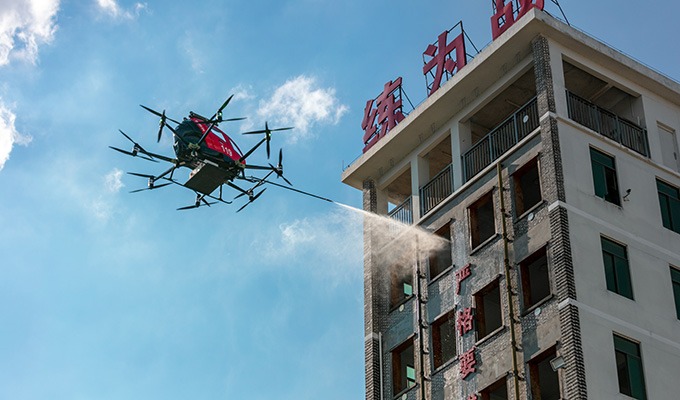Review - Ehang 216F firefighting drone highrise
The EHang 216F is an electric VTOL multicopter repurposed from the EHang 216 passenger platform, redesigned as an autonomous aerial firefighting vehicle for tackling high-rise fires. Launched in July 2020 by Guangzhou-based EHang, it's touted as “the world’s first large-payload intelligent aerial firefighting solution.”
Jon Wettack
8/9/20252 min read


🌆 What It Is
The EHang 216F is an electric VTOL multicopter repurposed from the EHang 216 passenger platform, redesigned as an autonomous aerial firefighting vehicle for tackling high-rise fires. Launched in July 2020 by Guangzhou-based EHang, it's touted as “the world’s first large-payload intelligent aerial firefighting solution.” (dronelife.com)
🧯 Key Capabilities & Design
Firefighting Equipment
Carries up to 150 L of foam and six projectile “firebombs” (ABC dry powder) per sortie (verticalmag.com). It includes a laser-guided window breaker to deploy agents directly inside tall structures (verticalmag.com).
Autonomous Precision
Uses a visible-light zoom camera to locate hotspots, hover, break windows, launch projectiles, and spray foam—all automatically or via remote dispatch (verticalmag.com).
Performance Specs
• Max altitude: ~600 m (1,970 ft)
• Max speed: ~130 km/h
• Flight endurance: ~21 min on battery
• Payload capacity: ~220 kg total (newatlas.com, evtol.news)
• Redundant safety: 16 motors/propellers, backup systems, emergency parachute (evtol.news)
Fleet Response
Designed for deployment from fire stations; can respond within a 3–5 km radius, with centralized fleet dispatch enabling rapid multi-unit response (dronelife.com).
🔍 Advantages & Use Cases
Reach & Speed: Accesses heights beyond standard ladders and hoses; avoids urban traffic delays (verticalmag.com).
Pilot-free deployment: Autonomous or remote operation reduces risk to personnel and cuts human response time.
Cluster coordination: Multiple drones can converge on a blaze to suppress it more swiftly (evtol.news, verticalmag.com).
Versatile urban tool: Enhances firefighting tactics in dense cities with tall structures where traditional methods fall short (businessinsider.com).
⚠️ Limitations & Considerations
Limited endurance: A 21-minute flight limits operation time; quick battery swaps are critical.
Payload constraint: Carries significantly less foam than helicopter-based systems (e.g., EC225 with 600 gal tank) (verticalmag.com).
Environmental sensitivity: High winds, intense heat, and smoke can affect stability and sensor performance.
Regulation & integration: Needs approval beyond technical certification—airspace rules, station retrofits, operator training.
Cost vs scale: While cheaper than full helicopters, it requires investment in infrastructure and centralized management.
🧩 Field Trials & Validation
Certification achieved: 216F passed a 10-month, 52-point test by China’s National Fire-Fighting Equipment (NFFE), clearing standards across flight control, heat/shock tolerance, wind and smoke environments (us.ehang.com).
Live exercise: Demonstrated in drills like the Laixi high-rise scenario (2021), alongside passenger drones, highlighting its window-breaking, foam spraying, broadcasting, and rescue supply capabilities (us.ehang.com).
🔭 Future Outlook
Potential Advances
Description
Extended endurance
Future iterations may include hybrid power systems or rapid battery swaps
Swarm operations
Teams of 216Fs could divide tasks—observation, suppression, rescue
Global deployment
Beyond China, urban fire departments worldwide may adopt the tech
Regulatory evolution
Success in drills may build trust for full-scale operational permission
🧠 Final Verdict
The EHang 216F is a compelling step forward in urban firefighting. It fills critical gaps in high-rise response: height reach, speed, autonomy, and risk reduction. Although constraints like battery life and payload size remain, its successful certification and field performance underpin strong potential.
If paired with supportive regulation, charging infrastructure, and integrated into fire brigade operations, this AAV could become a standard asset in 21st-century emergency response—especially for high-rise environments where traditional tools simply can’t reach.